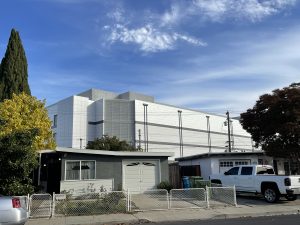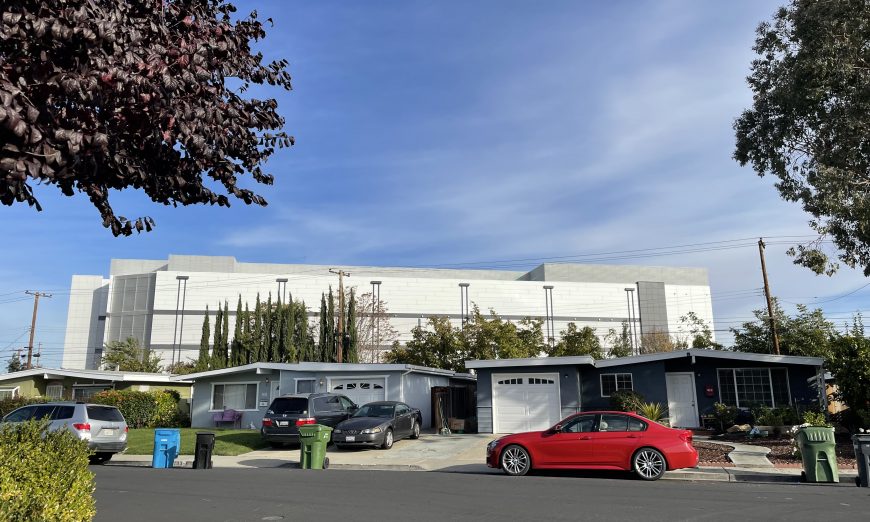Every time Alexandra walks out of her front door on Main Street in Santa Clara, she is jolted by the sight of one of the City’s newest data centers. The looming six-story building with more than 472,000 sq. ft. for data storage and 87,000 sq. ft. more for office space sits right on the edge of an industrial zone, less than 150 yards from the front door of her one-story single-family home.
“You could see the foothills from here and you could see the airplanes taking off. You could see everything. So, you could see the snow on the hill, on Mt. Hamilton, when it was up there,” said Alexandra. “But not anymore. Now we just see that.”
This was not part of the deal for Alexandra and her family. When she and her husband moved into the home in 2012, the data center wasn’t even in the planning stages. When the public meeting to discuss the proposed development came up, they weren’t invited.
“I know they had a public hearing, but apparently they only let everybody on that side of the street know that was being built behind them. Not that it was in front of us. So, my husband found out from one of our neighbors,” said Alexandra.
It turns out Alexandra lives just outside of the 300-foot radius required for meeting notification. In fact, just about every home on the other side of the two-lane Main Street is outside of that radius.

George also lives on the other side of Main Street and has lived there for 19 years, most of his life. For him, the building makes him uncomfortable.
“It feels like something really artificial being brought up into a place you grew up in, basically, like something that’s just not supposed to be there,” said George.
He’s also worried about what it means for him and his family and whether a building like that will mean his rent will rise again soon.
The people who live on the side of Main Street who were notified about the construction don’t have to look at the building every time they walk out of their front doors, so most say it doesn’t bother them. However, one homeowner did say this past summer felt hotter, as if the sun reflecting off the building was reflecting into her home.
It’s not clear if this is what the City envisioned when the project was approved by a unanimous vote of the Council on Nov. 9, 2021. During the meeting, City staff informed the Council of the concerns about the south boundary of the property, the side closest to Main Street.
Santa Clara council members were assured that the developer “softened” the elevation of the building and set it closer to the north side of the property to ease the neighborhood impact. City staff also downplayed how much of the data center would be seen from the neighborhood, saying it could be “potentially viewable from the backyards of residences on Main Street.”
For Alexandra, it’s more than that.
“It’s an eyesore,” said Alexandra.
Related Posts:
Santa Clarans Bear The Cost Of The Bay Area’s Cloud Storage
Santa Clara’s Data Drain








I live by city hall and I see this eye sore of a building everyday when I walk out it should of never been approved this close to the neighborhood. But again I’m not surprised it seems like the city is starting to care less about the people and more about the money.
People like Eric enjoy city services but have a problem with the city finding ways to pay for them.
I’m looking forward to his ideas on how he would raise revenues and also which services he would cut.
I agree with Eric. Maybe increase the property tax on those homes not lived in. There are several homes in Santa Clara that are owned and not occupied.
Data Centers: Remember this: None of this would matter if data centers were paying 82% of the City’s electricity bills. However, SVP’s current rate structure is stacked so that residents and small businesses are paying more than their fair share.
Cherie,
.
How do you figure that residents and small businesses are paying more than their fair share? Data centers and other big industrial customers of SVP pay a rate that provides profit to SVP and general fund dollars to the rest of us.
.
Residents only pay around 5% of SVP’s total revenues.
To make sure that something like this does not happen to your view it is a good idea to not choose to live adjacent to heavy industrial zones, separated only by railroad tracks.
.
Has the Silicon Valley Voice ever run any stories featuring the complaints of Levi’s Stadium neighbors, complaining about how that huge structure was built near them and which now looms in their view forever?
These buildings right next to residences should be much more moderate in height. A gradual shift, with lower heights near residences, and taller ones father away makes more sense.
Yes, these people live next to industrial areas, but industry needs to be a good neighbor.
I go through this area once or more a week.
For the life of me, from the article I cannot tell if this is at 1200 Memorex Drive. I THINK this Main St is on the OTHER side of the railroad tracks, and I figured in for airplanes, but then snow on Mt Hamilton threw me off.
Is this 1200 Memorex Drive?